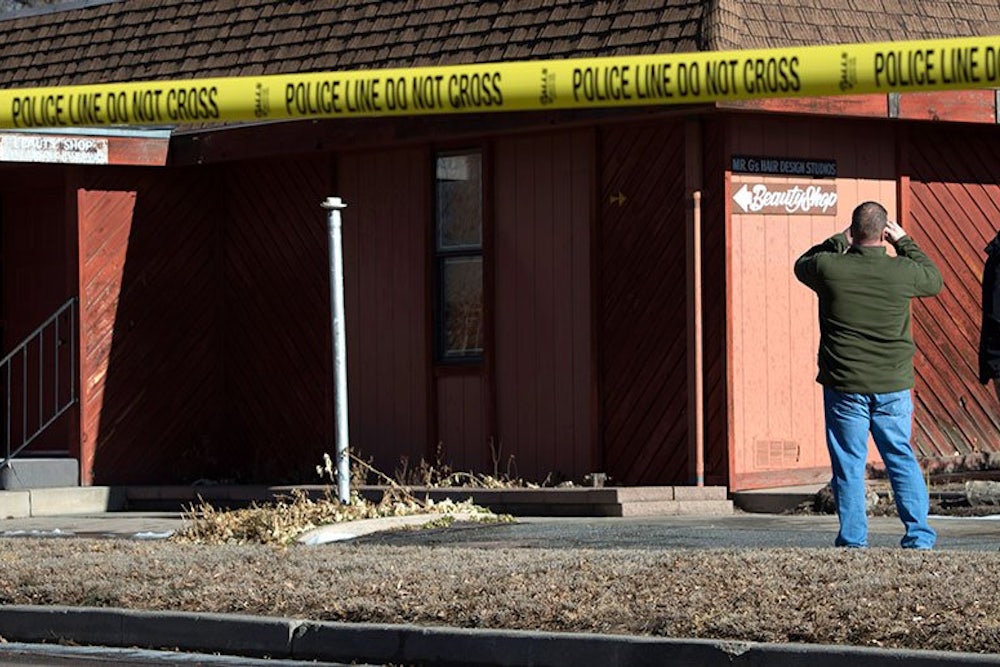The NAACP chapter in Colorado Springs, Colorado, is located on South El Paso Street in a one-story building with faded redwood siding, where it shares space with Mr. G’s Hair Design Studio. The surrounding streets are lined with modest, largely single-story homes. The men and women who work here—not just in the NAACP building, but also in the neighborhood—have been very busy lately, organizing local vigils and sending out e-mail blasts in response to the events in Ferguson, Missouri, and Staten Island, New York.
Late Tuesday morning, an improvised bomb exploded outside the building. No one was hurt or injured, though three people were working inside in Mr. G’s salon and two staffers were in the NAACP office. The explosion scarred the outside of the building, and knocked a few things off some shelves inside. The FBI has indicated that the bombing could well be motivated by hate, but that other motives are possible, too. Amy Saunders, a spokesperson for the Denver office of the FBI, told The Los Angeles Times that it wasn’t yet clear “if the motive was a hate crime, domestic terrorism, a personal act of violence against a specific individual,” or something else entirely.
The FBI is looking for a balding white man in his 40s who may be driving an old, dirty pickup truck. News organizations initially refused to identify the man’s race as “white,” though, despite having that fact in hand—a refusal that extends one of the principle benefits of white privilege to someone suspected of domestic terrorism. The New York Times, cribbing an Associated Press story but eliding the question of race, indicated that authorities were searching for “a man.” At least they covered the story, though. Many news outlets simply ignored it all together. And then, in what has become a ritual, outlets were called out on Twitter and Facebook for ignoring the bombing. “PLEASE,” actress Rashida Jones tweeted, “everybody, mainly national news outlets, CARE MORE ABOUT THIS.” If not for this grassroots #NAACPBombing campaign, we might not even be talking about this today.
It is too easy to explain the national media’s silence. The collective shrug in the first 24 hours after the event was, perhaps, evidence of a sort of racial fatigue, a consequence of the country’s collective desensitization to anti-black violence, to the drumbeat of stories about men and women and children who’ve been shot or tasered or thrown in jail. But it was also a reflection of the scarcity of details, and concern about covering a fast-moving story from a distance. The news moves so quickly, and a failed bombing—failed, that is, because no life was taken, no property destroyed—may have seemed hardly worth reporting. And then, even as the events in Colorado Springs slowly caught the attention of some, word came of the massacre at Charlie Hebdo in Paris.
The eclipse of the story only added to the frustration. On Twitter and in Colorado Springs, what began as a heartfelt plea for media attention quickly became a complaint about the algebra of media coverage, which makes room for only one big developing news story. This bitterness is understandable. It is a terrible thing to be caught up in a traumatic event of local significance—scrambling to learn more, earnestly believing that your story is a part of a long national nightmare linked not just to Ferguson but to violence against of NAACP offices a century ago—only to have an even more traumatic event, one that's part of another nation's growing nightmare, draw all the news attention. You might, in this set of circumstances, begin to suspect that your trauma will never even be seen, that it doesn’t even deserve to be forgotten. “Dear so-called journalists,” another tweet reads, “even if you don’t cover #NAACPBombing, it still happened.”
#NAACPBombing skeptics have wondered why so many have jumped to conclude, without supportive facts on the ground, that race was a factor in the bombing, asking instead whether there might not be a more pedestrian explanation. Indeed, it is unclear right now whether this bombing was an act of domestic terror or even a hate crime, but the assumption of domestic terrorism is a reminder that instead of becoming a post-racial nation with President Obama's election in 2008, as many hastily proclaimed, organized white supremacist and anti-government groups are on the rise (as are gun sales).
The enumeration of hate groups is perhaps less significant, though, than the depth of individual feeling, the darker passions that enable one to sit in a garage or a basement, stuffing a small pipe with loose metal fragments and gunpowder. Crafting a homemade IED and detonating it outside an NAACP office isn’t an act of whimsy. It emerges from the worst fever swamps of racism. Those can’t be so easily measured, because they are usually kept secret or private. It's one thing to launch a white supremacist website, sell David Duke t-shirts, distribute leaflets, spray-paint swastikas, and build a firing range. These acts don’t tell you whether someone is willing to try to kill. The true temperature of hate is best measured through an accounting of things like bombs.
